The world of lawn maintenance is full of choices, one of the most significant being the type of mower you use.
Have you heard of hydrostatic mowers? These machines, powered by a unique hydrostatic transmission system, offer seamless operation and outstanding maneuverability.
But what if you could enhance its performance even more? Enter the realm of pulley swapping. This modification could potentially improve speed, power, and overall performance.
But, can you pulley swap a hydrostatic mower?
Well, you can pulley swap a hydrostatic mower, but it requires careful and serious consideration. The process involves replacing the mower’s existing pulley with a different size, aiming to alter the speed or torque of the machine.
However, like all modifications, it has risks – including overheating the transmission, potential warranty avoidance, and more.
Are these risks worth the potential rewards? This question may have been gnawing at you, causing sleepless nights, and that’s exactly what we aim to answer.
This article will delve into pulley swapping on a hydrostatic mower, weighing the benefits against the risks, and guide you step-by-step if you decide to take the plunge.
So, are you ready to demystify the art of pulley swapping on hydrostatic mowers? Let’s delve in.

Table of Contents
What Are Hydrostatic Mowers?
Let’s move on to the world of hydrostatic mowers. These unique machines have revolutionized lawn maintenance with their innovative features and superior performance.
But what makes them stand apart from their counterparts? Let’s dive into the specifics to understand what hydrostatic mowers are, how they operate, and what advantages they bring.
Definition and Functionality
Hydrostatic mowers, named for their distinctive transmission system, are powerful tools in lawn care. Unlike traditional manual or automatic mowers, hydrostatic models use hydrostatic transmission to propel the mower. But what does that mean?
At its core, a hydrostatic transmission system uses fluids to transfer power from the engine to the wheels. In this system, a pump, driven by the mower’s engine, pressurizes oil in a closed system.
This pressurized fluid then powers a hydraulic motor, which drives the wheels. The beauty of this system is that it provides an almost infinite range of speed adjustments without any need for manual gear shifting.
This fundamental difference in the transmission system makes hydrostatic mowers distinctive from their manual and automatic counterparts.
While traditional mowers require gear changes to adjust speed, hydrostatic mowers allow smooth and easy transitions. Adjusting the lever changes the mower’s speed without jerky movements or gear shifts.
Additionally, hydrostatic mowers offer superior maneuverability. Traditional mowers may require maneuvering tricks for a tight turn, such as pushing down the clutch and pivoting the machine. Hydrostatic mowers, on the other hand, make turning as simple as pushing a lever.
This enhanced functionality and ease of use make hydrostatic mowers popular among homeowners and professional landscapers, despite typically being more expensive than manual or automatic mowers.
But as with any machine, there’s always room for improvement, and that’s where the idea of pulley swapping comes into play. But before we get into that, let’s look more closely at the benefits of hydrostatic mowers so well-loved.
Benefits of Hydrostatic Mowers
Hydrostatic mowers, while more expensive than traditional models, bring many benefits. Their superior functionality can make mowing less of a chore and more of a pleasure. Let’s delve into the specific advantages they offer.
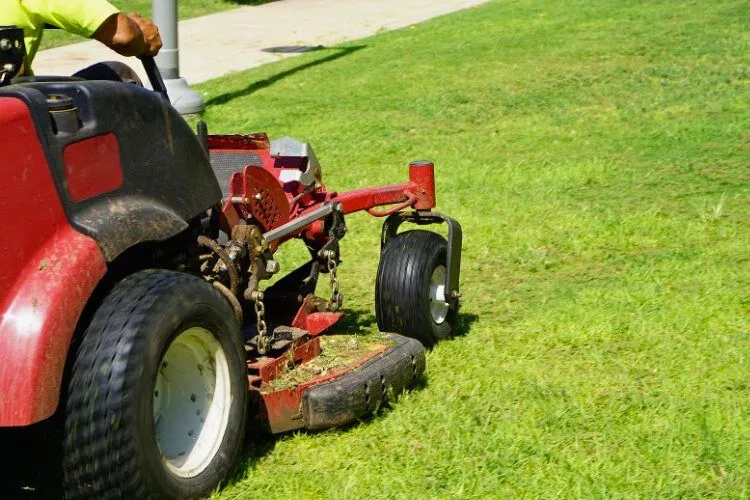
Smooth and seamless operation
The hydrostatic transmission system, by nature, offers an incredibly smooth operation. The fluid-powered propulsion eliminates jerky movements, providing a seamless ride.
This aspect makes hydrostatic mowers a great choice for lawns with various terrains. The mower effortlessly adjusts to hills and uneven surfaces, maintaining a smooth ride and consistent cutting height.
Ease of use and maneuverability
Using a hydrostatic mower is as simple as pushing a lever. There are no complicated gears to shift or clutches to manipulate.
Even tight turns are made easy with these mowers. Unlike traditional models that require complex maneuvering, hydrostatic mowers pivot smoothly, making them perfect for lawns with complex landscaping or tight corners.
Variable speed control
Perhaps one of the most appreciated features of hydrostatic mowers is the variable speed control. The mower’s speed can be finely adjusted using a simple lever or pedal without changing gears or engaging a clutch.
This means you can effortlessly slow down for tricky patches and speed up for long, straight runs. This level of control, combined with smooth operation and easy maneuverability, contributes to a mowing experience that’s efficient, effective, and enjoyable.
What is a Pulley Swap?
Now that we’ve delved into hydrostatic mowers, it’s time to introduce a concept that could potentially enhance their performance – the pulley swap. Let’s unwrap this term, understand its purpose, and explore how it applies to hydrostatic mowers.

Definition and Purpose
To understand what a pulley swap involves, we must first understand how pulleys play in a mower. Pulleys are essentially small wheels with grooved rims that rotate, transferring force from the engine to various mower parts. In the case of a hydrostatic mower, pulleys play a critical role in transmitting power from the engine to the hydrostatic transmission, which in turn drives the wheels.
So, what does it mean to swap a pulley?
Pulley swapping is a modification process in which the existing pulley on a mower is replaced with a different one. Depending on the desired result, this could involve changing to a larger or smaller pulley. The main purpose of a pulley swap is to alter the mower’s speed and performance.
How does this work? It’s a matter of simple physics. Increasing the size of the pulley on the mower’s engine (or reducing the size of the pulley on the transmission) increases the speed at which power is transferred from the engine to the wheels.
This results in a faster-moving mower. Conversely, reducing the engine pulley size or increasing the transmission pulley size will result in a slower but potentially more powerful mower.
Swapping a pulley can provide several advantages. First, it can enhance the mower’s speed, which is beneficial if you have a large area to mow and want to save time. Second, it can increase the mower’s power, which can help with tackling steep hills or tough, overgrown grass.
However, as with any modification, a pulley swap must be carefully considered. It’s essential to factor in various elements, which we’ll discuss in the next segment.
Factors to Consider Before Pulley Swapping
While the prospect of a speedier or more powerful mower is enticing, a pulley swap isn’t a decision to be taken lightly. Several factors need to be considered before you go ahead with this modification. Let’s delve into these crucial aspects to ensure a successful and safe pulley swap.

Manufacturer Recommendations
Before you contemplate a pulley swap, it’s important to thoroughly read through your mower’s owner’s manual. This guidebook often contains vital information on modifications and may have specific instructions or warnings about changing the pulley.
Manufacturers design and test their products to operate optimally under certain conditions. Altering the mower’s original setup can impact its performance and durability. The manual might highlight potential modification risks, such as pulley swapping.
Consider the implications a pulley swap might have on your mower’s warranty. Many manufacturers clearly state that any modifications can void the warranty, leaving you to cover the costs of any future repairs or replacements.
If the manual doesn’t provide clear guidance, or if you’re uncertain, it might be wise to contact the manufacturer’s customer service for advice. Your mower is an investment, and any modifications should be approached with due diligence to protect its functionality and longevity.
Compatibility and Availability
Once you’ve assessed the manufacturer’s recommendations, the next step is to consider the availability and compatibility of replacement pulleys for your specific mower model.
Firstly, research if there are pulleys available that are suitable for your model. Not all pulleys are created equal, and using a mismatched pulley can lead to poor performance or even damage your mower. Check online resources, visit local mower repair shops, or consult with experts to find a suitable pulley.
Compatibility is equally important. The new pulley must be compatible with your mower’s engine, the belt, and the transmission system. Incorrect size or fit can lead to inefficient operation, belt slippage, or excessive wear and tear. In worst-case scenarios, a wrong pulley can cause serious damage to your mower’s engine or transmission.
Remember, the goal of a pulley swap is to enhance your mowing experience, not to cause additional headaches. Ensuring the new pulley is compatible with your mower’s existing components is crucial to the success of this modification.
Performance and Safety Considerations
The final yet crucial factors to consider before a pulley swap revolves around performance and safety.
Firstly, understand that a pulley swap can significantly impact your mower’s performance and speed. A larger drive pulley or smaller driven pulley can make your mower faster, but it may also reduce torque, which can hinder your mower’s ability to handle steep hills or dense grass.
Conversely, a smaller or larger drive pulley can increase torque but will likely reduce the speed of your mower. It’s essential to find a balance that suits your specific mowing needs and the terrain of your lawn.
Safety should always be paramount when considering a pulley swap. Altering the pulley system can lead to increased mower speed, which might pose control and safety challenges, especially on uneven terrains. There’s also the risk of components failing due to increased stress or overheating, which could lead to injuries.
To minimize risks, always thoroughly check all components after the swap, and test your mower in a safe, open space before taking it to steep or crowded areas. Wear appropriate safety gear and stay vigilant about maintenance, especially in the first few uses post modification. Safety should never be compromised in the pursuit of improved performance.
Can you pulley swap a hydrostatic mower?
Yes, you can pulley swap a hydrostatic mower, but it’s not straightforward and requires careful consideration. A pulley swap involves replacing the mower’s existing pulley with a different size, aiming to alter the speed or torque of the machine.
However, this modification should not be taken lightly, as it can impact your mower’s performance, safety, and longevity.
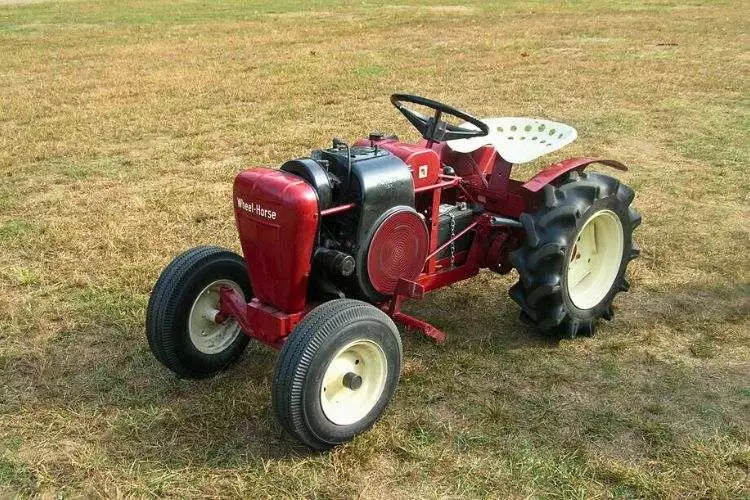
A successful pulley swap hinges on a few critical factors. Firstly, the replacement pulley must be compatible with your specific mower model and its existing components, such as the engine, the belt, and the transmission system. Incorrect compatibility can lead to inefficient operation or even damage.
Secondly, you must consider the potential impact on your mower’s performance. Changing the pulley size can increase the speed or torque, but increasing one often means a decrease in the other. Balancing your mowing needs and the mower’s capabilities is crucial.
Finally, safety is paramount. Increased speed or torque may lead to control challenges or component failure, potentially resulting in injuries.
Risks of pulley swapping a hydrostatic mower
While pulley swapping can offer appealing benefits, such as increased speed or torque, it’s equally crucial to understand the associated risks. Like any modification, pulley swapping can present potential drawbacks impacting your mower’s performance and longevity. Let’s investigate the key risks when considering a pulley swap on your hydrostatic mower.
Overheating the transmission
A prominent risk involved in pulley swapping a hydrostatic mower is the potential for overheating the transmission. Swapping to a larger or smaller drive pulley can cause your mower to operate at higher speeds.

However, this also means the transmission will work harder and run hotter than it was designed for. Over time, this added stress can lead to overheating, severely damaging the transmission components and degrading the mower’s performance.
Damaging the transmission
In addition to overheating, other forms of transmission damage are also a significant risk. The increased stress on the transmission from the altered pulley size can accelerate wear and tear on its components.
If the pulley swap is not done correctly, it could lead to incorrect belt tension, causing slippage or premature wear. Both can impact the transmission’s function and cause severe damage, leading to costly repairs or replacement.
Voiding the warranty
Lastly, it’s important to remember that modifying your mower in any way, including a pulley swap, can void your warranty. Most manufacturers stipulate that any unauthorized modifications can lead to a voided warranty.
Therefore, before proceeding with a pulley swap, it’s advisable to check the conditions of your warranty. If your mower is still under warranty, you might think twice about performing a pulley swap or risk being left with a costly bill should anything go wrong.
Benefits of pulley swapping a hydrostatic mower
While pulley swapping a hydrostatic mower presents risks, it’s essential not to overlook the potential benefits of this modification. With the right approach and careful execution, a pulley swap can enhance your mower’s performance in specific areas. Here’s a closer look at the advantages you could experience with a successful pulley swap on your hydrostatic mower.

Increased speed
The main advantage that drives many to consider a pulley swap is the potential for increased speed. By increasing the size of the drive pulley or decreasing the size of the driven pulley, you alter the mower’s gear ratio, which can result in a faster mowing speed. This can be particularly beneficial if you have large areas to mow, reducing the time spent on this chore.
Increased power
Another potential benefit of a pulley swap is increased power or torque. If you decrease the drive pulley size or increase the drive pulley, you can gain more torque on the wheels. This can be advantageous when you need more power, such as when mowing hilly or uneven terrain or dealing with thick, heavy grass.
Improved performance
When done correctly and under the right circumstances, a pulley swap can improve performance. The gains in speed or power can make your mowing tasks easier and more efficient. Moreover, for those who enjoy tinkering with their machines, the pulley swapping can provide a sense of accomplishment and a personalized touch to their mowing experience.
However, it’s crucial to remember that improvements will always be a balance between speed and power – generally, an increase in one results in a decrease in the other.
Steps to Pulley Swap a Hydrostatic Mower
Enhancing your mower’s performance might have piqued your interest in undertaking a pulley swap. However, before diving in, it’s important to understand the steps involved in this process. This section walks you through a step-by-step guide to pulley swapping a hydrostatic mower.
Always remember safety should be your top priority, and if you feel uncomfortable at any point, it may be best to seek professional assistance. Let’s dive in!
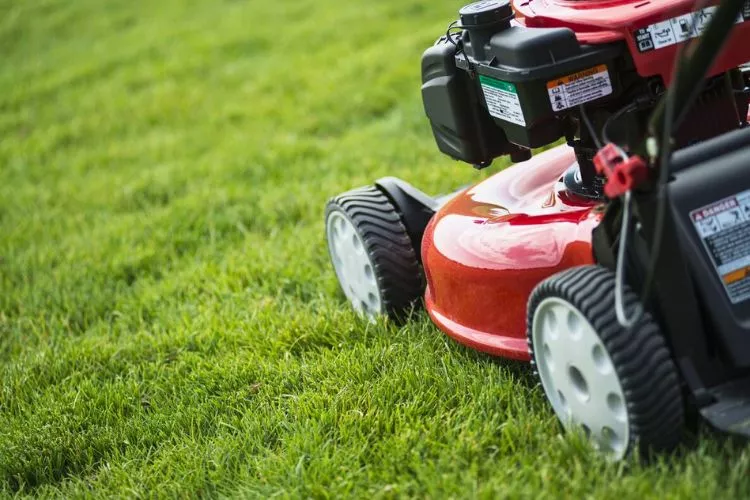
Preparation
Before embarking on the pulley swapping journey, adequate preparation is key. Gathering all necessary tools, safety equipment, and the correct replacement pulley is crucial. By ensuring everything is in place before you start, you can make the process smoother and safer.
Gather the Necessary Tools
To undertake a pulley swap, you’ll need specific tools. Typically, these would include:
- A wrench set (both metric and imperial)
- A pulley puller
- A torque wrench
- Pliers
- Screwdrivers
- A socket set
In addition, don’t forget your safety gear. It’s advised to have safety goggles, gloves, and sturdy footwear to protect yourself during the process.
Research and Purchase
The next step in your preparation is to identify the appropriate replacement pulley. This involves research, as you must ensure the selected pulley is compatible with your hydrostatic mower model. Consider factors such as the pulley’s size, material, and design.
You must find a reputable supplier once you’ve identified the right pulley. This could be a local hardware store, an online retailer, or even the mower’s manufacturer. Ensure you’re purchasing from a reliable source to avoid counterfeit or low-quality parts.
Removal of Old Pulley
With your tools ready and the new pulley purchased, it’s time to remove the old pulley. This involves locating the pulley assembly and carefully extracting the existing pulley.
Accessing the Pulley Assembly
Locating the pulley assembly is the first step in this process. In most hydrostatic mowers, the pulley is located at the mower’s base, underneath the cutting deck. To access it, you’ll need to raise the mower’s deck to its highest setting or even tip it on its side (make sure to drain oil and fuel first).
Remember, each mower model is unique, so consult your owner’s manual for specific instructions. Always ensure the mower is turned off and the key removed before you start working.
Removing the Old Pulley
Once you’ve accessed the pulley assembly, it’s time to remove the old pulley. Using your wrench set, loosen the bolt holding the pulley in place. Be careful as you remove it—these parts can be heavy and potentially sharp.
Here’s a step-by-step guide:
- Loosen the retaining bolt with a wrench.
- Use a pulley puller to dislodge the pulley.
- Carefully remove the pulley and retaining bolt.
After removal, ensure to store the old components in a safe place. You never know when they might come in handy. Also, it’s a good practice to keep the work area tidy to avoid losing parts or tripping over them.
Installation of New Pulley
Having successfully removed the old pulley, it’s time to install it. Ensuring the new pulley is prepared correctly and installed accurately is crucial to avoid any issues is crucial.
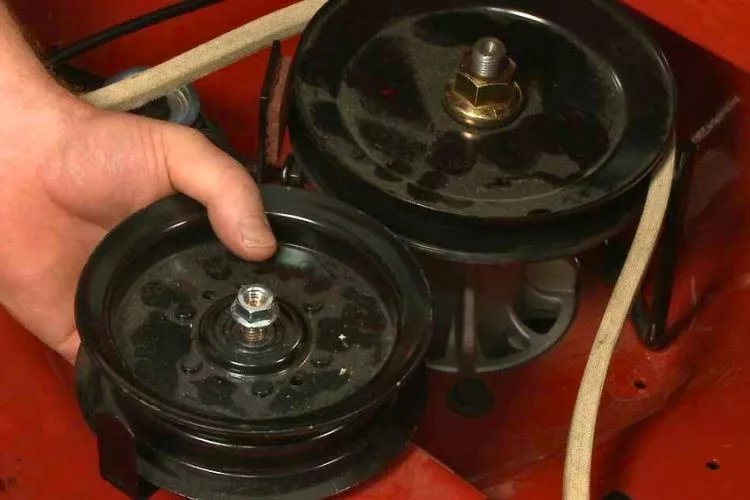
Preparing the New Pulley
Before you proceed with the installation, preparing the new pulley is important. This involves checking for any required modifications or adjustments that may need to be made to the new pulley to ensure it fits correctly and operates smoothly.
Don’t forget to clean the new pulley, removing any packaging residue or factory coatings. Also, a bit of lubrication on the hub and shaft will ensure smooth operation and prolong the life of your new pulley. Always use a lubricant appropriate for your specific mower model.
Installing the New Pulley
Once your new pulley is prepared, it’s time to install it. Here’s a step-by-step guide:
- Position the new pulley onto the mower’s shaft.
- Line up the bolt hole on the pulley with the hole on the shaft.
- Insert the retaining bolt and tighten it hand tight.
- Using your wrench, securely tighten the bolt. Do not overtighten, as it can damage the threads.
Remember, it’s crucial to ensure proper alignment. Misalignment can cause the belt to wear unevenly or even break. If unsure, always refer to your mower’s manual or seek professional help.
Testing and Adjustment
Once the new pulley is installed, the job isn’t done just yet. It’s time to test and adjust your machine to ensure everything works properly and achieve the best performance.
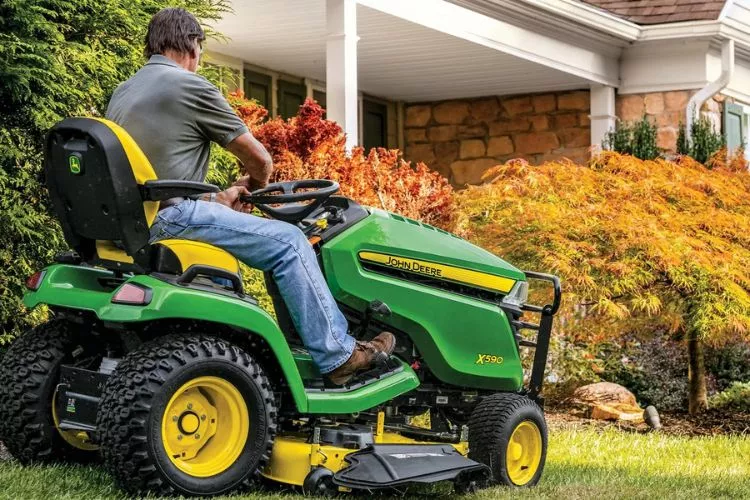
Verifying the Pulley Swap
Verifying the pulley swap is crucial to ensuring your mower is ready to operate at its best. Start your mower and listen for any unusual sounds – unusual noises might indicate a problem with the installation.
While the mower is running, look for issues like wobbling pulleys or slipping belts. Remember, your new pulley should operate smoothly and without excessive vibration.
Signs of a successful pulley swap include a smoothly running machine with increased speed and power without any unusual noise or vibrations.
Adjustments and Fine-Tuning
Once you have verified that the new pulley has been installed correctly, you might need to adjust and fine-tune it to get the most out of your mower.
This involves calibrating the new pulley system for optimal performance. You may need to adjust the tension on the belt or tweak the throttle linkage to get the desired speed.
Also, you might find the mower’s handling slightly different due to the increased speed. So, spend some time fine-tuning it until you’re comfortable with how it handles.
In all these, patience is key. Do not rush the process. Make small adjustments, and test after each adjustment until you achieve the desired performance. Remember, safety should always come first!
Frequently Asked Questions (fAQs)
Can pulley swapping void my mower’s warranty?
Yes, pulley swapping can void your mower’s warranty. Most manufacturers consider it a modification, and it’s recommended to check your warranty terms before proceeding.
How can I determine if my hydrostatic mower is compatible with pulley swapping?
Check the owner’s manual, consult with the manufacturer, or reach out to a professional mechanic to determine the compatibility of your mower for pulley swapping.
Are there any professional services available for pulley swapping?
Yes, many lawn equipment repair shops or professional mechanics offer pulley swapping services. It’s always good to seek professional help if unsure about the process.
Can pulley swapping improve the performance of my hydrostatic mower?
Yes, pulley swapping can improve the performance of your hydrostatic mower, potentially increasing speed and power. However, it should be done properly to avoid damaging the mower.
What is the difference between a pulley swap and a governor removal?
A pulley swap involves changing the pulley size to increase the mower speed, while a governor removal disables a device designed to limit the mower’s top speed. Both can increase speed but have different risks and complexities.
Conclusion:
To sum up, pulley swapping on a hydrostatic mower is a feasible task offering potential benefits like increased speed, power, and performance.
However, it’s important to carefully consider the various factors, risks, and manufacturer’s recommendations before proceeding.
A pulley swap should always be conducted safely and with the right tools and techniques for optimal outcomes. We hope that this guide has been helpful.
You can read about similar topics here on our website. Check back again soon for more.

